What Is The Pinckney Treaty
| | |||||||||||||||||||||||||||||
| |||||||||||||||||||||||||||||
| 175 members of the Balloter College 88 electoral votes needed to win | |||||||||||||||||||||||||||||
|---|---|---|---|---|---|---|---|---|---|---|---|---|---|---|---|---|---|---|---|---|---|---|---|---|---|---|---|---|---|
| Turnout | 36.8%[one] | ||||||||||||||||||||||||||||
| |||||||||||||||||||||||||||||
| Presidential election results map. Green denotes states won past Madison, burnt orange denotes states won by Pinckney, and low-cal green denotes states won by Clinton. Numbers betoken the number of electoral votes bandage by each country. | |||||||||||||||||||||||||||||
| |||||||||||||||||||||||||||||
The 1808 United States presidential election was the sixth quadrennial presidential election, held from Friday, Nov iv, to Wed, December 7, 1808. The Democratic-Republican candidate James Madison defeated Federalist candidate Charles Cotesworth Pinckney decisively. Madison's victory made him the get-go private to succeed a president of the same political party.
Madison had served as Secretary of State since President Thomas Jefferson took office in 1801. Jefferson, who had declined to run for a third term, threw his strong back up behind Madison, a fellow Virginian. Sitting Vice President George Clinton and quondam Ambassador James Monroe both challenged Madison for leadership of the political party, simply Madison won his party's nomination and Clinton was re-nominated equally vice president. The Federalists chose to re-nominate Pinckney, a former ambassador who had served as the political party's 1804 nominee.
Despite the unpopularity of the Embargo Act of 1807, Madison won the vast bulk of electoral votes exterior of the Federalist stronghold of New England. Clinton received half-dozen balloter votes for president from his home state of New York. This ballot was the first of two instances in American history in which a new president was selected simply the incumbent vice president won re-election, the other being in 1828.
Nominations [edit]
Democratic-Republican Party nomination [edit]
| | |||||||||||||||||||||||||||||
| James Madison | George Clinton | ||||||||||||||||||||||||||||
|---|---|---|---|---|---|---|---|---|---|---|---|---|---|---|---|---|---|---|---|---|---|---|---|---|---|---|---|---|---|
| for President | for Vice President | ||||||||||||||||||||||||||||
| | | ||||||||||||||||||||||||||||
| 5th U.Due south. Secretary of State (1801–1809) | quaternary Vice President of the United States (1805–1812) | ||||||||||||||||||||||||||||
Presidential candidates [edit]
- James Madison (Virginia), Secretary of Land
- James Monroe (Virginia), Quondam U.S. Ambassador to the United kingdom
- George Clinton (New York), Vice President of the United States
Vice-presidential candidates [edit]
- George Clinton (New York), Vice President of the United states of america
- John Langdon (New Hampshire), Governor
- Henry Dearborn (Massachusetts), Secretary of War
- John Quincy Adams (Massachusetts), United states Senator
Conclave [edit]
Senator Stephen R. Bradley, who had chaired the congressional nominating conclave during the 1804 presidential ballot, made a call for the 1808 conclave to the 146 Democratic-Republican members of the The states Congress and Federalist allies. The caucus was attended by 89 to 94 members of Congress.[2]
The caucus was held in January 1808, and Secretary of State James Madison won the presidential nomination with the support of President Thomas Jefferson against James Monroe and Vice President George Clinton. The conclave voted to give the vice-presidential nomination to Clinton against his main opponent John Langdon although Clinton's supporters believed that he would receive the Federalist's presidential nomination, just information technology instead went to Charles Cotesworth Pinckney. A commission of fifteen members was selected to manage Madison'southward campaign.[2] [three]
Seventeen Democratic-Republicans in Congress opposed Madison's selection and the conclave system whose authority to select presidential and vice-presidential candidates was disputed. Clinton also opposed the conclave system.[2] Monroe was nominated by a group of Virginia Democratic-Republicans, and although he did not actively endeavor to defeat Madison, he also refused to withdraw from the race.[4] Clinton was besides supported past a group of New York Democratic-Republicans for president even as he remained the party's official vice presidential candidate.[v]
Balloting [edit]
| Presidential Ballot | Total | Vice Presidential Ballot | Total |
|---|---|---|---|
| James Madison | 83 | George Clinton | 79 |
| James Monroe | 3 | John Langdon | five |
| George Clinton | 3 | Henry Dearborn | iii |
| John Quincy Adams | 1 |
Federalist Party nomination [edit]
| | |||||||||||||||||||||||||||||
| Charles C. Pinckney | Rufus King | ||||||||||||||||||||||||||||
|---|---|---|---|---|---|---|---|---|---|---|---|---|---|---|---|---|---|---|---|---|---|---|---|---|---|---|---|---|---|
| for President | for Vice President | ||||||||||||||||||||||||||||
| | | ||||||||||||||||||||||||||||
| Former U.S. Minister to France (1796–1797) | Former U.S. Minister to Great Uk (1796–1803) | ||||||||||||||||||||||||||||
The Federalist caucus met in September 1808 and re-nominated the party'southward 1804 ticket, which consisted of General Charles Cotesworth Pinckney of South Carolina and former Senator Rufus King of New York.[6]
General ballot [edit]
Campaign [edit]
The election was marked by opposition to Jefferson'south Embargo Human activity of 1807, a halt to trade with Europe that unduly hurt New England merchants and was perceived as favoring France over U.k.. Nonetheless, Jefferson was still very popular with Americans mostly and Pinckney was soundly defeated by Madison, though non as badly as in 1804. Pinckney received few electoral votes exterior of New England.
Results [edit]

Pinckney retained the electoral votes of the two states that he carried in 1804 (Connecticut and Delaware), and he besides picked upwardly New Hampshire, Massachusetts, Rhode Island, and 3 balloter districts in North Carolina likewise the 2 balloter districts in Maryland that he carried earlier. Except for the N Carolina districts, all of the improvement was in New England.
Monroe won a portion of the popular vote in Virginia and North Carolina,[4] while the New York legislature split up its electoral votes between Madison and Clinton.[5]

| Presidential candidate | Party | Home state | Pop vote(a), (b) | Balloter vote(c) | Running mate | |||
|---|---|---|---|---|---|---|---|---|
| Count | Pct | Vice-presidential candidate | Domicile state | Electoral vote(c) | ||||
| James Madison | Democratic-Republican | Virginia | 124,732 | 64.7% | 122 | George Clinton (incumbent) | New York | 113 |
| John Langdon | New Hampshire | 9 | ||||||
| Charles Cotesworth Pinckney | Federalist | South Carolina | 62,431 | 32.4% | 47 | Rufus King | New York | 47 |
| George Clinton | Democratic-Republican | New York | — | — | 6 | James Madison | Virginia | 3 |
| James Monroe | Virginia | 3 | ||||||
| James Monroe | Democratic-Republican | Virginia | 4,848 | two.5% | 0 | None | N/A | 0 |
| Unpledged electors | None | N/A | 680 | 0.4% | 0 | N/A | Northward/A | 0 |
| Total | 192,691 | 100% | 175 | 175 | ||||
| Needed to win | 88 | 88 | ||||||
Source (Pop Vote): United states Presidential Elections, 1788-1860: The Official Results past County and State [vii]
Source (Pop Vote): A New Nation Votes: American Election Returns 1787-1825 [8]
Source (Balloter Vote): "Electoral College Box Scores 1789–1996". National Archives and Records Assistants. Retrieved July 30, 2005.
(a) Only ten of the 17 states chose electors by pop vote.
(b) Those states that did choose electors by popular vote had widely varying restrictions on suffrage via holding requirements.
(c) One Elector from Kentucky did not vote.
Pop vote past state [edit]
The popular vote totals used are the elector from each party with the highest total of votes. The vote totals of N Carolina and Tennessee appear to be incomplete.
| State | James Madison Democratic-Republican | Charles C. Pinckney Federalist | James Monroe Democratic-Republican | Margin | Citation | ||||
|---|---|---|---|---|---|---|---|---|---|
| # | % | # | % | # | % | ||||
| Kentucky | ii,679 | 98.02% | 54 | 1.98% | No ballots | ii,625 | 96.04% | [9] | |
| Maryland | xv,336 | 63.31% | 8,886 | 36.69% | No ballots | 6,450 | 26.62% | [10] | |
| New Hampshire | 12,793 | 47.60% | fourteen,085 | 52.40% | No ballots | -1,292 | -4.lxxx% | [11] | |
| New Jersey | xviii,670 | 55.97% | 14,687 | 44.03% | No ballots | 3,983 | 11.94% | [12] | |
| North Carolina | 8,829 | 51.08% | 7,523 | 43.53% | 931 | 5.39% | 1,306 | 7.55% | [xiii] |
| Ohio | 3,645 | threescore.82% | ane,174 | xix.59% | 1,174 | xix.59% | 2,471 | 41.23% | [xiv] |
| Pennsylvania | 42,518 | 78.37% | eleven,735 | 21.63% | No ballots | 30,783 | 56.74% | [15] | |
| Rhode Isle | 2,692 | 46.70% | three,072 | 53.30% | No ballots | -380 | -half dozen.sixty% | [16] | |
| Tennessee | 1,016 | eleven | No ballots | [17] | |||||
| Virginia | xv,683 | 78.62% | 761 | 3.81% | 3,505 | 17.57% | 12,178 | 61.05% | [18] |
Close states [edit]
States where the margin of victory was under 5%:
- New Hampshire, 4.viii% (i,292 votes)
States where the margin of victory was under x%:
- Rhode Island, 6.6% (380 votes)
- N Carolina, 7.55% (1,306 votes)
Electoral college pick [edit]

Results by county explicitly indicating the percentage of the winning candidate in each county. Shades of blue are for Madison (Democratic-Republican), shades of yellow are for Pinckney (Federalist), and shades of green are for Monroe (Democratic-Republican).
| Method of choosing electors | State(s) |
|---|---|
| Each Elector appointed past country legislature |
|
| Each Elector chosen by voters statewide |
|
| State is divided into balloter districts, with one Elector chosen per district by the voters of that district |
|
Meet as well [edit]
- History of the United states of america (1789–1849)
- First inauguration of James Madison
- 1808 and 1809 United States Firm of Representatives elections
- 1808 and 1809 United States Senate elections
References [edit]
- ^ "National General Ballot VEP Turnout Rates, 1789-Present". Us Ballot Project. CQ Press. Archived from the original on November 14, 2016.
- ^ a b c National Party Conventions, 1831-1976. Congressional Quarterly. 1979.
- ^ Sabato, Larry; Ernst, Howard (January 1, 2009). Encyclopedia of American Political Parties and Elections. Infobase Publishing. pp. 302–304.
- ^ a b Ammon, Harry (1963). "James Monroe and the Election of 1808 in Virginia". The William and Mary Quarterly. 20 (one): 33–56. doi:10.2307/1921354. JSTOR 1921354.
- ^ a b Kaminski, John P. (1993). George Clinton: Yeoman Pol of the New Commonwealth. Rowman & Littlefield. pp. 281–288. ISBN9780945612186 . Retrieved October 12, 2015.
- ^ Deskins, Donald Richard; Walton, Hanes; Puckett, Sherman (2010). Presidential Elections, 1789-2008: Canton, State, and National Mapping of Election Data. University of Michigan Printing. pp. 49–fifty.
- ^ Dubin, Michael J. (2002). United States Presidential Elections, 1788-1860: The Official Results by County and Country. Jefferson: McFarland & Company. p. 15. ISBN9780786410170.
- ^ "A New Nation Votes". elections.lib.tufts.edu. Archived from the original on May 13, 2018.
- ^ "A New Nation Votes". elections.lib.tufts.edu . Retrieved October 8, 2020.
- ^ "A New Nation Votes". elections.lib.tufts.edu . Retrieved October 8, 2020.
- ^ "A New Nation Votes". elections.lib.tufts.edu . Retrieved October viii, 2020.
- ^ "A New Nation Votes". elections.lib.tufts.edu . Retrieved Oct 8, 2020.
- ^ "A New Nation Votes". elections.lib.tufts.edu . Retrieved October 8, 2020.
- ^ "A New Nation Votes". elections.lib.tufts.edu . Retrieved October 8, 2020.
- ^ "A New Nation Votes". elections.lib.tufts.edu . Retrieved October 8, 2020.
- ^ "A New Nation Votes". elections.lib.tufts.edu . Retrieved Oct 8, 2020.
- ^ "A New Nation Votes". elections.lib.tufts.edu . Retrieved October viii, 2020.
- ^ "A New Nation Votes". elections.lib.tufts.edu . Retrieved October 8, 2020.
Farther reading [edit]
- Brant, Irving, "Election of 1808" in Arthur Meier Schlesinger and Fred L. Israel, eds. History of American presidential elections, 1789-1968: Volume 1 (1971) pp 185-249
- Carson, David A. "Quiddism and the Reluctant Candidacy of James Monroe in the Ballot of 1808," Mid-America 1988 seventy(2): 79–89
External links [edit]
![]()
- Ballot of 1808 in Counting the Votes Archived October one, 2019, at the Wayback Machine
- Presidential Election of 1808: A Resource Guide from the Library of Congress
- "A Historical Analysis of the Balloter College". The Light-green Papers . Retrieved March 20, 2005.
- A New Nation Votes: American Election Returns, 1787-1825
What Is The Pinckney Treaty,
Source: https://en.wikipedia.org/wiki/1808_United_States_presidential_election
Posted by: stroupfene1942.blogspot.com

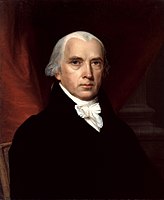
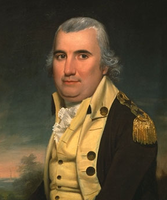



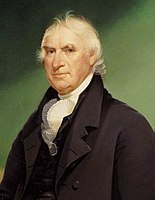
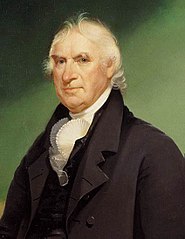
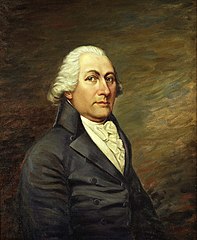
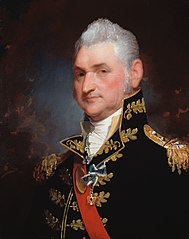


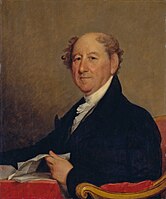

0 Response to "What Is The Pinckney Treaty"
Post a Comment